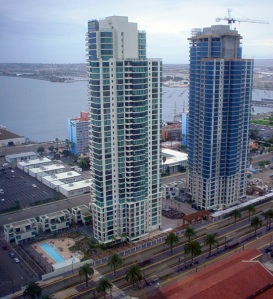A Placemaking Journal
Do We (Still) Need Vancouver?
 A few years ago Urban Guru Leon Krier asked this question — “Do we still need Vancouver?” — at CNU XVII Denver. In response, the Next Generation of New Urbanists invited then-new Vancouver planning director Brent Toderian to speak in favor of Vancouver, which is easy to do. For, since the fall of Hong Kong, Vancouver has been reinvented to become one of the world’s most livable cities, and a model for urbanization.
A few years ago Urban Guru Leon Krier asked this question — “Do we still need Vancouver?” — at CNU XVII Denver. In response, the Next Generation of New Urbanists invited then-new Vancouver planning director Brent Toderian to speak in favor of Vancouver, which is easy to do. For, since the fall of Hong Kong, Vancouver has been reinvented to become one of the world’s most livable cities, and a model for urbanization.

Urban Vancouver.
While Leon emphatically stated “No” in answering his own question, San Diego has answered with a resounding “Yes.” Former Vancouver planning director, Larry Beasley, easily sold his city and its developers to other north American city booster groups, and San Diego smartly bought it. Hook. Line. Sinker. Our downtown redevelopment agency leadership actively pursued Vancouver developers Bosa and Intracorp and changed the local building codes to allow for single-core podium towers with a suburban townhouse wrap on the street.
All the rage, the imported Vancouver model was built very quickly and effectively changed our downtown and its skyline until the economy inadvertently solved for our affordable housing issues. With our downtown development experiencing a dramatic pause (or contemplative lull), it’s now easier to reconsider just what happened to my city, and where do we go next?
So, I’ve concluded that Leon was wrong… as well as right.
He is correct in his assertion that the Vancouver model is really urbanism-lite and a contradiction of both suburban and urban. The single common entry frontages to the towers choke the flow of people like a vertical cul-de-sac. The towers themselves celebrate and elevate a private imperialism of residential glass fishbowls that looms over and dominates the public realm below. And, he is correct to point out that the suburban townhouses that ‘wrap’ were used to ‘hide’ the urbanism of the narrow point tower that woefully undermines urban intensities with luxury, view-oriented condos. The ground floor townhouse wraps also limit access into the urbanized block with their single private stoop entries fronting the majority of the block. A contradiction, the model is simultaneously a little too much and a little too little… but for San Diego, it was just right.
Contrarily, I find Leon incorrect is in his frame of reference. He is correct to assert that urbanism-lite in a European or east coast USA context is a mistake. However, from 1947 to 1997, San Diego effectively emptied out, made illegal, disenfranchised and completely disinvested in our previously vital downtown. It was lost, gone, and could not be (RE)vitalized as all of its vitality was completely sapped. We had to (RE)learn how to build and live downtown. As local Urban Guru Michael J. Stepner, FAIA, FAICP, smartly points out, “When downtown was vibrant in 1940s, we were a city of 250,000 people. Redeveloping downtown today is occurring in the context of a region with 3 million people.”
As with the rest of the US west, ours is a relatively new downtown with a renewed purpose and vitality. But, it took the perceived design safety of the Vancouver model to teach us that downtown was safe again. With its security-guarded common entry lobbies, urban dwellers are effectively sequestered behind their gated stoops. Add the safety of the townhouse wrap and you’ve got a strong sell that downtown can embody the aesthetic comforts of suburbia. In response, here in San Diego, bored suburbanites were lured back downtown.The model smartly assembled building types without the loathed double loaded hallway corridors and essentially lowered the number of overall units per block. Therefore, for San Diego, the Vancouver model was the appropriate block type to vitalize downtown again.

The traditional face of urbanism.
The lessons of the Vancouver model, good and bad, have been studied and learned. Now’s the time for next steps. A more 3-dimensional urbanism, where people connect at the street, and at the 3rd, 6th, and upper floors… and back down to the street. The blocks will be more permeable, translucent, engaged. The street will be the entry, rather than the edge, of the blocks, and we will grow closer to the ground as we need less privatized security and more penetration into where people live, work and play. I now agree with Leon that Vancouver is not the appropriate model to urbanize San Diego’s future (though he visited San Diego in 2009 and surprised me with an appreciation for our towers, finding them playful, even fun, and certainly not as oppressively repetitive as he had seen in Vancouver and on the east coast), but it was a necessary step to encourage generations of people traumatized by the bucolic safety of suburbia to emerge from their paneled dens to walk, talk, shop, and have fun with each other downtown.
–Howard Blackson




